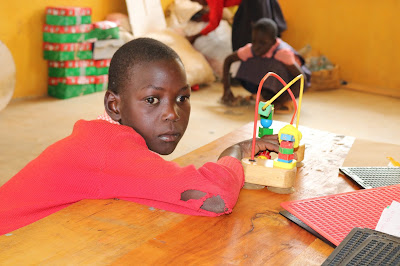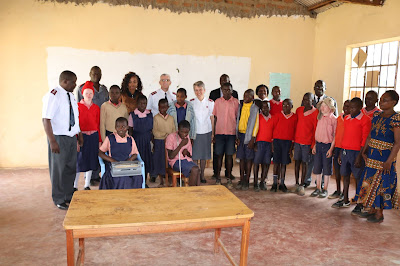Intense weather and silver linings
Climate change and global warming are hot topics of
discussion around the world. Not surprisingly, it was an agenda item for the
recent G7 Summit in Quebec. The implications
and impact continue to perpetuate dialogue as scientific and political sectors keep
trying to understand and address inevitable consequences for thousands of people
and hundreds of communities universally.
Extreme weather patterns appear sporadically
in so many places. Families and civic infrastructures experience havoc and loss
from the effects of severe storms, drought, floods, hurricanes, erupting
volcanoes, etc.
Arriving in Kenya in early 2017, the relentless high
temperatures were causing intense drought which meant poor crops, loss of human
and animal life, and accelerating poverty. Fast forward twelve months and the environmental
pendulum has swung the other way to excessive rain falls instigating destructive
flooding. Who would have thought?
A few weeks ago, a dam burst in one Kenyan town, due to
substantial rainfall, resulting in the loss of many lives and substantial ruin
of property. A news story detailed how the “flood waters swept away power lines,
homes, and buildings, including a primary school.” The Salvation Army was part of the emergency response teams. In an even
broader context, the news relayed how “hundreds of thousands of people across
Kenya, Somalia, Ethiopia, and Uganda have been displaced by torrential rain in
the last two months.”
Soon we discovered how flash floods had reached the
northern county of Turkana, the same area in our Territory where harsh drought
struck a year ago. Many people are displaced because the floods have
destroyed their houses and livestock. Some roads are impassable increasing the
challenge for families seeking refuge. Various agencies and humanitarian aid
groups are responding to provide for the immediate needs of food and shelter. The county government is assessing the
emerging and long term needs too. Our Salvation Army Territorial Projects
department has been on the ground doing its review and are currently partnering
with International Headquarters in a “rapid response” to support the area. The Army’s motto, ‘heart to God and hand to
man’, steps into high gear.
While pondering the hostile effects of acute weather, I saw a small, silver lining in the cloud of unpredictable climate. The few rivers we see around Kenya have
reached new levels of rising water. While
driving by one not far from our house, I caught a glimpse of a young man standing knee deep in
the middle of the river with a long pole extended into the water. I knew he
wasn’t fishing. Our driver, Arnold, enlightened my curiosity. The high rolling
water actually provided great conditions for harvesting sand from the river
bed. The flooded water way meant the ground below was stirring up, allowing
easier access to the sediment at the bottom.
Attached to the end of the submerged pole was a net that would catch the
soil enabling the harvester to sift it, leaving behind what was not useful and
harvesting a quality sand product. Even
without a net, using your hands for this work is also common. The sand would be
carried out of the river in sacks thrown across the harvester’s shoulders. I imagine the young man’s back was aching and
sweat pouring down his face as he labored in the hot sun for many hours,
another example of the local physical work required every day. A good result of this
strenuous job, however, would be the valuable sand resource, an essential
ingredient for making cement and asphalt, very useful for the expanding
construction industry in Kenya. Despite the tiring work, this could at least
be one benefit from excessive rain and flooding.
Another step back to scan the bigger picture
though enlightened me a little more. In 2014 the UN reported more than 40 billion tonnes of sand are
extracted annually around the globe, initiating a potential calamity. The
concern is whether the frequency of harvesting sand exceeds nature’s rate of
replenishing it. I learned that sand
harvesting has the potential to “destroy vegetation, affect the flow of water
along the rivers, erode the waters’ holding capacity of the river bed, and
destroy ecosystems. With the depletion of sand on riverbeds, harvesters target
farmland.” (https://www.nation.co.ke/oped/opinion/-increased-sand-harvesting/440808-4300774-178uig/index.html
) To help alleviate this fear, the law
dictates sand harvesters must have a licence and adhere to regulations in an
attempt to manage the environmental impact. I soon realized there is more here
than meets the eye. I know my inquiry is very limited so I make no assumptions.
But I did recall again the wide reaching complexities of atmospheric
forces on our fragile world and the quest many have to find ways to live within
current realities.
This reflection can leave me unsettled. I can't underestimate the challenges and threats which surround people every day but it also conjures up valuable
principles. I am still inspired by those
who can extract something good when circumstances are tough, even when that good isn’t perfect.
As well, I remember there
are a myriad of perspectives in any given situation. A broad outlook and an inquisitive mind can
help deepen our understanding and potentially better our responses, or
certainly our judgments. I also consider
every precious gift of life as a resource worth handling with care. And I see
once more how interdependent we all are.
The ‘refining’ process of harvesting sand also elicits a
moral and ethical response. How important is it to ‘sift out’ what is not
needed in our lives or what may tarnish the best in us. A good question for all
of us - what purging or refining might be required on either a practical or spiritual
basis? Could it be about eliminating the ‘stuff’ that is seriously not necessary
(de-cluttering) or does it mean removing habits or behaviours that are just
wrong? I wonder what spiritual or moral filtering
would allow greater portions of goodness, kindness, integrity, honesty,
generosity and compassion to rise to the top.
As a leader, how can I ensure the pure ‘fine sand’ of humility, wisdom,
and justice to be the products that shape my heart and mind as I influence and
lead others?
Extreme weather is intense and unfortunately reaps
devastation for many. Let’s pray that there will be more silver linings to
discover, other lessons to learn, and increased ways to own our part for the
world we all long to see.
In the meantime, the promise of God from the prophet is: “When you pass through the waters, I will be
with you; and when you pass through the rivers, they will not sweep over you.
When you walk through the fire, you will not be burned … do not be afraid for I
am with you.” (Isaiah 43)
A picture taken on my phone by the side of the road












